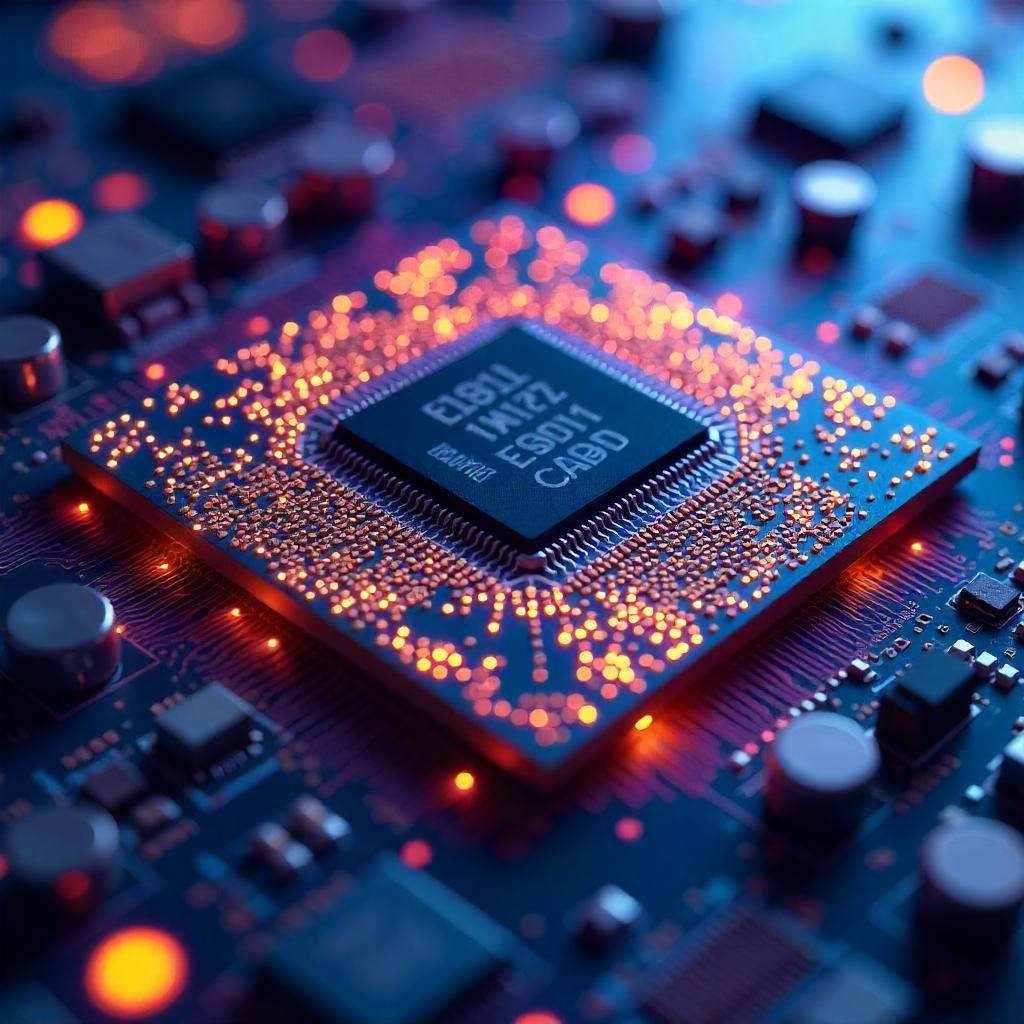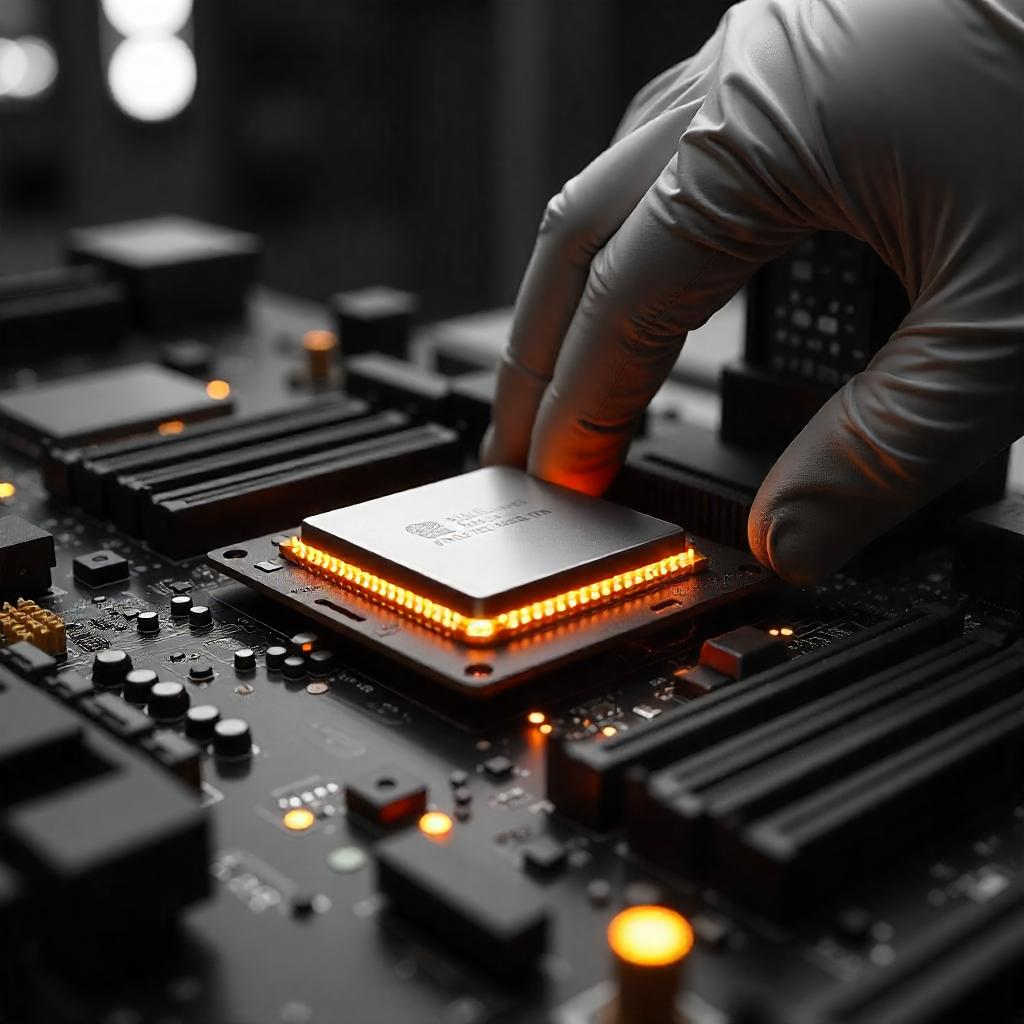You’re battling it out in Mecha BREAK, and the screen erupts with dazzling explosions, each ray-traced spark rendered so vividly it feels like a sci-fi blockbuster. Meanwhile, your laptop is crunching an AI model to generate a photorealistic artwork in seconds, all without breaking a sweat. This isn’t just raw computing power—it’s the magic of AI-accelerated GPUs, blending neural intelligence with graphics muscle to revolutionize gaming and creative workflows. In 2025, GPUs like NVIDIA’s GeForce RTX 5070, AMD’s Radeon RX 9070 XT, and Intel’s Arc Pro B60 are using AI to render smarter visuals and accelerate professional tasks. With the global GPU market projected to hit $270 billion by 2029, growing at a 33% CAGR, AI-accelerated GPUs are transforming how you game, create, and work. Let’s dive into how these GPUs work, spotlight top models, and explore why they’re your ticket to smarter rendering in 2025.
The AI-GPU Revolution: Smarter, Not Just Faster
Picture a GPU as the artist behind your screen’s visuals, painting every pixel with precision. Traditional GPUs relied on brute force—thousands of cores crunching math to render games or process data. AI-accelerated GPUs, however, are like artists with a brain, using neural networks to optimize rendering, predict workloads, and enhance efficiency. These GPUs leverage specialized hardware, like NVIDIA’s Tensor Cores, AMD’s Matrix Cores, and Intel’s XMX AI cores, to handle AI-driven tasks, from upscaling game graphics to accelerating machine learning, per NVIDIA Blog.
Key AI-driven features include:
- Neural Rendering: AI generates up to 90% of game pixels, reducing traditional rendering to a “rough sketch,” per @DrJimFan on X. This boosts frame rates and visual fidelity, per NVIDIA Blog.
- AI Upscaling: Technologies like NVIDIA’s DLSS 4, AMD’s FSR 4, and Intel’s XeSS 2 use AI to upscale low-resolution images to 4K, improving performance, per Tom’s Hardware.
- AI Workloads: Tensor and Matrix Cores accelerate deep learning tasks, like image generation in Stable Diffusion, per Ankr.com.
- Efficiency: AI optimizes power usage, cutting energy costs by 30–40%, aligning with eco-friendly trends, per EETimes.com.
In 2025, these GPUs are powering everything from gaming PCs to AI-driven workstations, with @NVIDIAGeForce hyping DLSS 4’s 6.5x frame rate boost in Diablo IV: Sins of the Horadrim at 4K, per @NVIDIAGeForce. For you, this means a PC that renders cinematic games and crunches AI tasks faster, smarter, and greener.
Top AI-Accelerated GPUs for 2025: Your Power Picks
Here’s our curated lineup of the best AI-accelerated GPUs for 2025, selected for their rendering prowess, AI capabilities, and consumer appeal, based on recent industry updates and community sentiment.
1. NVIDIA GeForce RTX 5070
- Price: $699
- Specs: Blackwell GB205 GPU, 6,144 CUDA cores, 12GB GDDR7, 672 GB/s bandwidth, 1,850 TOPS AI performance, 4nm TSMC process.
- AI Features: DLSS 4 with Multi Frame Generation, 4th-gen Tensor Cores, RTX Neural Shaders, 300W TDP.
- Why It’s Stellar: Launched at CES 2025, the RTX 5070 delivers 1440p gaming with AI-driven upscaling, boosting Mecha BREAK by 6x at 4K, per NVIDIA Blog. Its Tensor Cores accelerate AI tasks like Stable Diffusion, per Ankr.com. @cstanley on X calls it a “fundamental shift” in rendering, per @cstanley.
- Your Gain: Play Half-Life 2 RTX with AI-enhanced visuals or generate AI art on a mid-range PC, ideal for gamers and creators.
2. AMD Radeon RX 9070 XT
- Price: $549 (estimated)
- Specs: RDNA 4 architecture, 32 compute units, 16GB GDDR6, 2x ray-tracing performance, FSR 4 upscaling, 250W TDP.
- AI Features: Matrix Cores, Hypr-RX optimizations, 40% reduced latency, PCIe Gen 5.
- Why It’s Stellar: Unveiled at Computex 2025, it offers 30% better efficiency than RDNA 3, with FSR 4 upscaling for 1440p gaming, per 9meters.com. @hms1193 on X notes its 2x ray-tracing boost, per @hms1193. It handles light AI tasks like local LLMs, per Tom’s Hardware.
- Your Gain: Enjoy Cyberpunk 2077 with ray tracing at 1440p or run AI-driven video editing, perfect for budget-conscious gamers.
3. Intel Arc Pro B60
- Price: $399
- Specs: Battlemage Xe2 architecture, 12GB GDDR6, 56 Xe cores, XeSS 2 upscaling, 200W TDP.
- AI Features: XMX AI cores, 25% better efficiency, optimized for AI inference and creative workloads.
- Why It’s Stellar: Launched at Computex 2025, it targets creators and AI developers, delivering 2x performance in Blender and Llama 3.1 inference, per Intel Newsroom. Its XeSS 2 upscaling ensures playable 1080p ray tracing, per TechRadar.
- Your Gain: Render 3D models or run AI chatbots on a budget, ideal for indie creators and students.
4. NVIDIA RTX 4060
- Price: $299
- Specs: Ada Lovelace architecture, 3,072 CUDA cores, 8GB GDDR6, 3rd-gen Tensor Cores, 115W TDP.
- AI Features: DLSS 3, RTX Neural Texture Compression, 100 TOPS AI performance.
- Why It’s Stellar: A budget-friendly option, it powers 1080p gaming with AI-enhanced visuals, per PCMag. Its Tensor Cores accelerate small-scale AI tasks, per Ankr.com. Ideal for cost-conscious gamers, per IGN.
- Your Gain: Play Overwatch 2 with ray tracing or edit videos with AI effects, great for casual users.
5. NVIDIA RTX A6000
- Price: $4,600
- Specs: Ampere architecture, 10,752 CUDA cores, 48GB GDDR6, 4th-gen Tensor Cores, 300W TDP.
- AI Features: FP8 precision, RTX Virtual Workstation support, NVLink for multi-GPU setups.
- Why It’s Stellar: A workstation GPU, it excels in AI training and 3D rendering, per Atlantic.net. Its 48GB memory handles large datasets, per GPU-mart.com.
- Your Gain: Train complex AI models or render high-res animations, ideal for professionals.
How AI-Accelerated GPUs Transform Work and Play
Gaming: Cinematic Worlds, Smarter Rendering
AI-accelerated GPUs make games feel like interactive movies:
- Neural Rendering: RTX Neural Shaders generate textures in real-time, enhancing classics like Half-Life 2 RTX, per NVIDIA Blog. @NVIDIAGeForce notes a 6.5x FPS boost in Diablo IV, per @NVIDIAGeForce.
- AI Upscaling: DLSS 4 and FSR 4 upscale 1080p to 4K, boosting Phantom Blade Zero frame rates by 6x, per NVIDIA Blog.
- Low Latency: NVIDIA Reflex and AMD Hypr-RX cut input lag by 40%, critical for esports like Valorant, per 9meters.com.
- Ray Tracing: AI-enhanced ray tracing delivers lifelike lighting in Control, per Tom’s Hardware.
For you, this means playing Mecha BREAK at 1440p with cinematic visuals, even on a budget GPU like the RTX 4060, per our ray-tracing GPUs article.
Work: AI-Powered Productivity
AI-accelerated GPUs supercharge creative and professional tasks:
- Content Creation: Tensor Cores accelerate Adobe Premiere and Blender, cutting render times by 50%, per Ankr.com. The RTX A6000 handles 8K video editing, per Atlantic.net.
- Generative AI: Run Stable Diffusion or FLUX.1 locally on RTX 5070, generating images in seconds, per NVIDIA Blog.
- Data Analysis: GPUs like the Arc Pro B60 process large datasets for AI inference, per Intel Newsroom.
- Efficiency: AI optimizes power usage, reducing energy costs, per EETimes.com.
For you, this means editing 4K videos, generating AI art, or analyzing data on a laptop without cloud reliance, per our AI-optimized chips article.
Choosing Your GPU: Tips for Work and Play
Picking an AI-accelerated GPU depends on your needs:
- Gaming Focus: The RTX 4060 ($299) for 1080p or RX 9070 XT ($549) for 1440p, per PCMag. DLSS 4 offers the best upscaling, per IGN.
- Creative Work: The RTX 5070 ($699) balances gaming and AI tasks; the RTX A6000 ($4,600) is for pros, per Atlantic.net.
- Budget: The Arc Pro B60 ($399) offers value for AI and light gaming, per TechRadar.
- System Specs: Pair with 16GB+ RAM, a PCIe 5.0 motherboard, and 400W+ PSU, per Tom’s Hardware. Check cooling, per our cooling innovations article.
- Software: Ensure apps support Tensor/Matrix Cores (e.g., TensorFlow, PyTorch), per MobiDev.biz.
Pro Tip: Use MSI Afterburner to monitor GPU performance and optimize settings, per Reddit.com.
Challenges to Watch
- Cost: Premium GPUs like the RTX A6000 ($4,600) are pricey; budget options like the RTX 4060 ($299) are accessible, per PCMag.
- Power Draw: The RTX 5070’s 300W TDP requires robust PSUs, per TotalPhase.com.
- Software Support: Some apps lag in leveraging AI cores, per Computerworld.
- Availability: RTX 50 Series stock may be limited, per NextPlatform.com.
- Privacy: AI features may collect data, so review settings, per our GDPR Policy.
GadgetShaker suggests checking software compatibility and PSU capacity, per TechRadar.

The Future of AI-Accelerated GPUs
By 2030, AI-accelerated GPUs will evolve:
- Full Neural Rendering: 90%+ of game pixels AI-generated, per @DrJimFan.
- 2nm Processes: 60% efficiency gains, per Korea Herald.
- 6G Integration: Enhanced cloud rendering, per our 5G article.
- Eco-Friendly Designs: Lower power draw, per our sustainable laptops article.
For you, expect GPUs that make gaming and AI tasks faster, greener, and more immersive.
GadgetShaker’s Picks: Your AI-GPU Ally
We’ve tested AI-accelerated GPUs to find your perfect match. The NVIDIA RTX 5070 leads for gaming and AI balance, while the Intel Arc Pro B60 is a budget gem for creators. Questions about the RX 9070 XT or RTX A6000? Drop them on our Contact Us page or comment below! Look out for guides like “Best AI-Accelerated GPUs for 2025” or “How to Optimize Your PC for AI Rendering.”
Final Thoughts: Smarter Rendering, Unleashed
AI-accelerated GPUs in 2025, like the NVIDIA RTX 5070, AMD RX 9070 XT, and Intel Arc Pro B60, deliver smarter rendering for work and play. With neural rendering, AI upscaling, and efficient designs, they power cinematic gaming and AI-driven workflows. Despite challenges like cost and software support, their impact is transformative. Stay connected with GadgetShaker.

